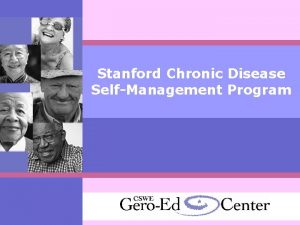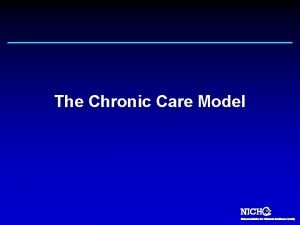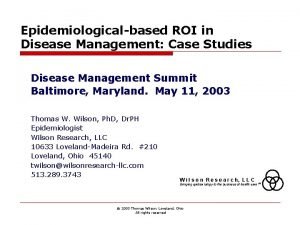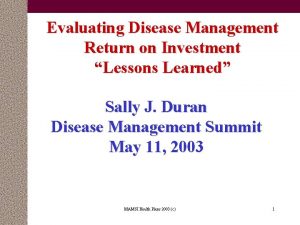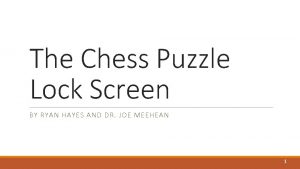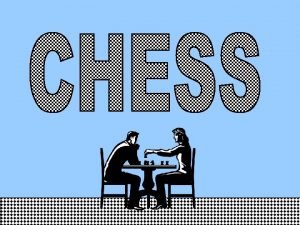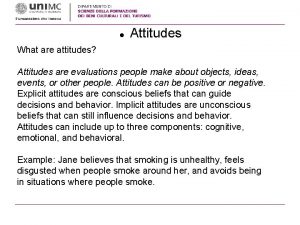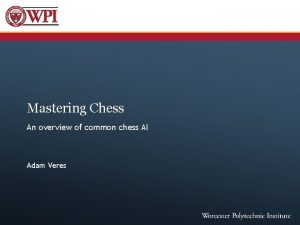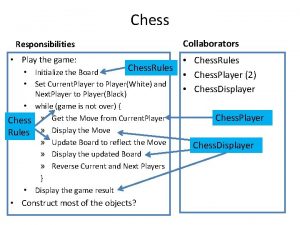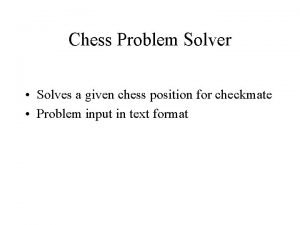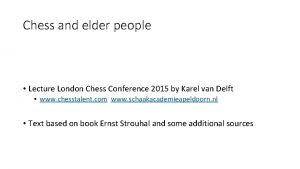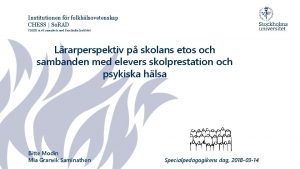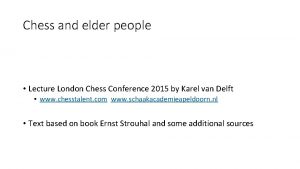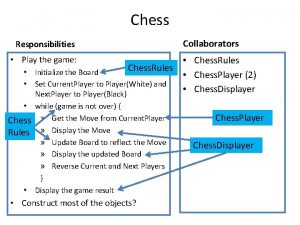Consumer Attitudes Toward Disease Management David Chess MD


























- Slides: 26

Consumer Attitudes Toward Disease Management David Chess MD President & CEO Enhanced Care Initiatives May 10, 2006

Questions ? ? ? • What do we know about attitudes toward Disease Management? • How useful are satisfaction surveys? And what have they told us? • What can we gather from the literature as to consumer attitudes and needs? • How might we better meet the articulated needs? • How might we structure such a program? • When can we use common sense?

Who Cares? ? • Consumers (PATIENTS and FAMILIES) don’t know that DM exists, let alone have an attitude about it.

DM Attitudes Towards Consumers • DSM programs developed by companies to accomplish two purposes (but one real purpose): – Improve care in patients with chronic illness • Save money – Decrease hospitalization and other expensive resources • Save money – Most Programs are Disease Focused targeting those patients who spend the money. • Only need to ‘satisfy’ patient to keep them in the program (The real customer is the payer) • Programs almost never designed around what the patient needs or wants but are prescriptive

Health Care 101 - Follow the $$$$$ The Health Buck Starts Here Step 1 Employers Government $$$$$ Step 4 The Patient The Cost Center Step 2 MCOs $$$$$$ They get the money to pay for your health Step 3 DM $ The Cost Containment Strategy

Consumers View of DM What we learned: • Unable to find specific research or data on consumer attitudes toward DM. Some limited data on focused case and care management for specific conditions • Limited research on consumers’ wants in health care, particularly senior population. May be a proxy • Satisfaction surveys traditionally a proxy-don’t tell us what the consumer wants or needs • Surveys only recently included consumer perspective

Satisfaction Surveys – Maybe the Next Best Tool, But…. • • No standard tool used by all DSM companies Some administer themselves, others outsource Timing of surveys varies Usually only survey those in the program, not the dis-enrolled or non-participating • Participation rates generally low • Often considered ‘happiness’ survey

DMAA Member Satisfaction Project • Striving for methodological validity including: – Objective survey sampling and data collection methodologies – Relevant and validated survey questions – Appropriate survey frequency – Adequate survey response rate

Questions to Consider • What do we want from a satisfaction survey? • Are we asking the ‘right‘ questions? • Is the survey inquiring about what the patient really needs? • Does satisfaction with a DSM program measure the effectiveness of interventions?

Survey of DSM Companies • Six companies contacted, asked the following questions: – Who does your patient survey? – What is your return rate? [#returned/# sent] – % of responses in top 2 categories? – When is first survey sent? Frequency thereafter?

Short Survey of DSM Satisfaction Surveys A B C D Outsource yes yes Return rate 5 -25% = 200 55% - 1000 [Tele] 50% [Tele] 35% = 6722 % Top 2 categories 85 -90% 96 -97% 90 – 95% 90. 5% Frequency annually 4 wks post hosp Annually [p 12 mos active] Q 6 mos starting after 6 mos

What Do Surveys Tell Us? • • • Little about the patient attitudes Return rates low even with telephonic surveying All measure ‘happiness’ with program All show similar results 2 programs ‘touch’ the patient Ø 1 has relatively short term involvement • 2 are telephonic only

What Does Other Research Tell Us • Certain issues and gaps cry out – – – Coordination of care Access to care Information, communication, and education Respect for patient’s values, preferences and expressed needs Emotional support-alleviation of fear and anxiety • Care needs escalate with multiple chronic conditions • Needs intensify further as frailty increases and ADL’s impacted

What We Know • Relationships are the fundamental building block essential for change – Patient/doctor relationship • Most DM companies try to have the same nurse work with a patient – Patient behavior change is much enhanced by working with a trusted person – Chronically ill patients with multiple comorbidities require more hands on to influence behavior – The frail and elderly often suffer from isolation and a lack of relationships

The Gap • • Dr. visits are brief Patients only retain 20 % of visit Messaging is complex Patient compliance complicated by isolation and depression • Complicated by decrease cognitive function • DM programs have limited impact on this population

What About Current DM Programs? • These patients often sicker, not able to meet criteria, regular telephone contact • Seem to slip thru the cracks • Recognized by MCOs as being high risk and costly • Need a different model of care focusing on care, keeping them well enough to stay at home • Model still needs to be cost effective

The Solution Patient Centered Model of Care for the Medically Complex • • • Hands on Community Programs Scalable Defined Content Able to integrate into the existing health care system Able to integrate with the medical infrastructure of MCO’s

The Pyramids Medical Management Systems Patient Costs Complexity High Low Intensity of Services Population Size Enrollees

Dramatic Decrease in Hospital Expenditures Analysis of Hospital Costs and Related Activity Hospital Costs Without Interventional Support 60 Patients tracked for 2 years prior to intervention and 13 months of intervention With Interventional Support During Pilot 13 month period * Source: Bridgeport, CT Hospital Pilot Data, January 2000

Patient Centered Care – Care In The Home –Health Management “Patients can undo a months worth of expensive and intensive care by just going home and going about their normal routine” Ø Community-based ECI Nurse or Nurse Practitioner conducts patient visits Ø Comprehensive Health Status Evaluation Ø Gap-filling education - family, caregiver and patient Ø Proper use of medication Ø Address depression and Isolation Ø Implement disease-specific exercise program Ø Home safety improvements Ø Coordinating and integrating care Ø Reviewing/upgrading nutrition Ø Initiating health monitoring systems Ø Defining advance medical directive

Patient Centered Care – In the Community for the Most Impaired “The community is one of the most strategically important ingredients to improved health and outcomes” Ø Weekly group meetings Ø Catalyzed socialization – Overcome Isolation Ø Coffee and Cookies Ø Introductions to new people Ø Recreation and Entertainment Ø Exercise programs – New Level of Fitness Ø Geriatric pharmacist reviews medication Ø Nurse monitoring for adherence / warning signs Ø Meds Ø Vitals Signs Ø Communicates issues with MD Ø Motivation Ø Nutrition Ø Exercise

The Physician Message Ø “We exist to fill in a known and growing information gap between your patients evolving condition and your treatment strategy. ” Ø “We are an MD-directed, comprehensive, community-based nursing intervention program built to enhance your care and fill in the gaps between what you prescribe and what your patient does. ” Ø “We work to reconnect the individual within their community, to improve socialization and decrease depression and isolation. ” Ø “We coordinate care ”

Caregiver Solution – Supporting, Stabilizing the Home ØCaregiver Support Program offers: ØInformation and Referral Sources ØEmotional Counseling Hotline 24 / 7 ØLegal Guidance Hotline ØFinancial Guidance Hotline ØVeterinarian Hotline

The Electronic Health Record – The Brains Ø Software is the engine driving care Ø Patient Selection – HRA, MDS, administrative data Ø Efficient data entry Ø All tools are point click and hand writing recognition. Ø Integrated Patient Specific Care Plans Ø Integrated Care Guidelines Ø Integrated Reports – For the patient, family, physician Ø Integrated Communications – Web based with Fax and email capability Ø Integrated Bio-Metric tools Ø Integrated Dashboards – to drive Outcome metrics Ø Integrated Outcome Reporting – On over 150 outcome measures Ø Integrated Nurse activity tracker

The Magic Sauce Ø Ø Ø Ø Hands on Intervention, EMR – driving efficiency and outcomes Addresses Depression and Isolation Caregiver Support Disease Specific Exercises Full suite of Bio. Metric monitoring devices True Integration with Physician Delivering Care in the home- Nurse Practitioners oversee treatment with the patient’s physician Ø Integrating evidence based care guidelines. Ø Case management – coordinating and integrating care Ø Measurable Outcomes

Consumer Attitudes We don’t know much • What we do know is that most consumers don’t know what DM is. • We know that DM is a cost savings strategy • Improved health outcomes is the Tactic used to control costs • That the people most impaired need the most contact and Relationship is the most important driver of behavior change • Easy Care – Community Care Management Program is a vehicle to create Relationship, Health Outcomes and Cost Savings
 Primary and secondary consumers
Primary and secondary consumers Mughal dynasty
Mughal dynasty Cashless philippines
Cashless philippines David chess md
David chess md Bharathi viswanathan
Bharathi viswanathan Decomposer in the sahara desert
Decomposer in the sahara desert Cengage
Cengage Consumer research process
Consumer research process Black box model consumer behaviour
Black box model consumer behaviour Chapter 5 consumer markets and buyer behavior
Chapter 5 consumer markets and buyer behavior Pneumatic reduction of intussusception
Pneumatic reduction of intussusception Phototherapy for newborn's nursing interventions
Phototherapy for newborn's nursing interventions Kate lorig chronic disease self-management
Kate lorig chronic disease self-management Disease management association of america
Disease management association of america Wagner's chronic care model
Wagner's chronic care model Nursing management of liver cirrhosis
Nursing management of liver cirrhosis Disease management roi
Disease management roi Methods of plant disease management
Methods of plant disease management Disease management roi
Disease management roi Puzzle lock screen
Puzzle lock screen Chess pieces cheat sheet
Chess pieces cheat sheet Chess piece cheat sheet
Chess piece cheat sheet Chess uml
Chess uml Jesus and devil playing chess
Jesus and devil playing chess Chess heuristic
Chess heuristic Peas description for chess player
Peas description for chess player Chess and the art of enterprise architecture
Chess and the art of enterprise architecture












